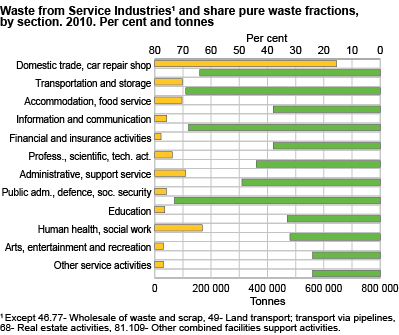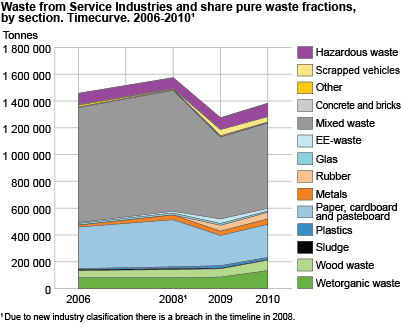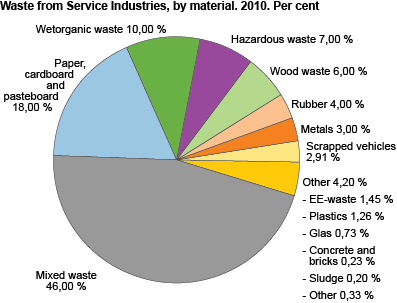Content
Published:
This is an archived release.
Less waste in the service industries
The service industries generated almost 1.4 million tonnes of waste in 2010. This is 12 per cent less than in 2008. As much as 47 per cent of the waste originated in the domestic trade business. Almost half of the waste consisted of mixed waste.
|
Several figures were corrected 12 December 2011 at 10:15 a.m. Diagrams were published at this time as well. |
Almost 650 000 tonnes of waste came from the domestic trade business in 2010, which is almost the same amount as in 2008. In second and third place are human health and social work and administrative, support service, with 12 and 8 per cent of the total waste amounts respectively.
Service industriesService industries is a collective term that includes wholesale and retail trade, hotels and restaurants, transport, storage and communication, financial intermediation, real estate, renting and business activities, together with public and personal services. This corresponds to section G-U in the Standard Industrial Classification (SIC2007) . For the time being, the statistics cover section G-S, except 46.77- wholesale of waste and scrap, 49- land transport; transport via pipelines, 68- real estate activities. |
Although as much as 77 per cent of the Norwegian workforce was employed in the service industries in 2010, only 17 per cent of the waste disposed in Norway came from these industries.
More waste efficient
The waste amounts from the service industries have decreased by 12 per cent since 2008.
In comparison, the value added (basic prices, constant 2005 prices) for the industry increased by nearly one per cent during these two years. This implies that the industry has become more waste efficient.
Most mixed waste
In 2010, almost 640 000 tonnes, or 46 per cent, was collected as mixed waste. This is a 30 per cent decrease compared to 2008. In this context, mixed waste is defined as waste that cannot be classified as pure fractions. For the waste fractions of wet organic waste, wood, plastics, metals, rubber, EE waste, scrapped vehicles and hazardous waste, there has been an increase since 2008. This increase can to some extent be attributed to an enhanced sorting effort by the industries and more attention to hazardous waste collection.
New industry classificationA new version of the Norwegian industry classification (SIC2007) was implemented in January 2009. The reclassification of publishing activities from the manufacturing industry to the service industries is the most important change. |
Uncertainty in the figuresThe calculations are based on customer registers from a sample of waste collectors. Some of the customers probably delivered a few pure waste fractions to waste collectors outside the sample, or to receivers outside the waste collection business. The total amount of waste and the amount of pure fractions may therefore be too low, while the share of mixed waste may be too high. |
Tables:
Contact
-
Camilla Skjerpen
E-mail: camilla.skjerpen@ssb.no
tel.: (+47) 48 22 72 14
-
Gisle Berge
E-mail: gisle.berge@ssb.no
tel.: (+47) 48 12 19 97



